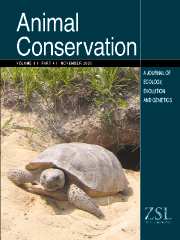Crossref Citations
This article has been cited by the following publications. This list is generated based on data provided by
Crossref.
Nicholls, Henry
2004.
One of a kind.
Nature,
Vol. 429,
Issue. 6991,
p.
498.
Gaur, A.
Reddy, A.
Annapoorni, S.
Satyarebala, B.
and
Shivaji, S.
2006.
The origin of Indian Star tortoises (Geochelone elegans) based on nuclear and mitochondrial DNA analysis: A story of rescue and repatriation.
Conservation Genetics,
Vol. 7,
Issue. 2,
p.
231.
Parent, Christine E
Caccone, Adalgisa
and
Petren, Kenneth
2008.
Colonization and diversification of Galápagos terrestrial fauna: a phylogenetic and biogeographical synthesis.
Philosophical Transactions of the Royal Society B: Biological Sciences,
Vol. 363,
Issue. 1508,
p.
3347.
CIOFI, CLAUDIO
TZIKA, ATHANASIA C.
NATALI, CHIARA
WATTS, PHILLIP C.
SULANDARI, SRI
ZEIN, MOCH S. A.
and
MILINKOVITCH, MICHEL C.
2011.
Development of a multiplex PCR assay for fine‐scale population genetic analysis of the Komodo monitor Varanus komodoensis based on 18 polymorphic microsatellite loci.
Molecular Ecology Resources,
Vol. 11,
Issue. 3,
p.
550.
Chiari, Ylenia
and
Claude, Julien
2011.
Morphometric identification of individuals when there are more shape variables than reference specimens: A case study in Galápagos tortoises
.
Comptes Rendus. Biologies,
Vol. 335,
Issue. 1,
p.
62.
POULAKAKIS, NIKOS
RUSSELLO, MICHAEL
GEIST, DENNIS
and
CACCONE, ADALGISA
2012.
Unravelling the peculiarities of island life: vicariance, dispersal and the diversification of the extinct and extant giant Galápagos tortoises.
Molecular Ecology,
Vol. 21,
Issue. 1,
p.
160.
Benavides, Edgar
Russello, Michael
Boyer, Donal
Wiese, Robert J.
Kajdacsi, Brittney
Marquez, Lady
Garrick, Ryan
and
Caccone, Adalgisa
2012.
Lineage Identification and Genealogical Relationships Among Captive Galápagos Tortoises.
Zoo Biology,
Vol. 31,
Issue. 1,
p.
107.
HUNTER, ELIZABETH A.
GIBBS, JAMES P.
CAYOT, LINDA J.
and
TAPIA, WASHINGTON
2013.
Equivalency of Galápagos Giant Tortoises Used as Ecological Replacement Species to Restore Ecosystem Functions.
Conservation Biology,
Vol. 27,
Issue. 4,
p.
701.
Edwards, D. L.
Garrick, R. C.
Tapia, W.
and
Caccone, A.
2014.
Cryptic structure and niche divergence within threatened Galápagos giant tortoises from southern Isabela Island.
Conservation Genetics,
Vol. 15,
Issue. 6,
p.
1357.
McAllister, Chris T.
Duszynski, Donald W.
and
Roberts, David T.
2014.
A New Coccidian (Apicomplexa: Eimeriidae) from Galápagos Tortoise,Chelonoidissp. (Testudines: Testudinidae), from the Dallas Zoo.
Journal of Parasitology,
Vol. 100,
Issue. 1,
p.
128.
Bloor, Paul
Ibáñez, Carolina
and
Viloria‐Lagares, Thomas A.
2015.
MitochondrialDNAanalysis reveals hidden genetic diversity in captive populations of the threatened American crocodile (Crocodylus acutus) in Colombia.
Ecology and Evolution,
Vol. 5,
Issue. 1,
p.
130.
Branson, Maile A.
Atkinson, Shannon
and
Ramos, Meg Ferrell
2016.
Hormonal profiles of captive Galapagos tortoises (Chelonoidis nigra).
Zoo Biology,
Vol. 35,
Issue. 3,
p.
237.
Miller, Joshua M
Quinzin, Maud C
Scheibe, Elizabeth H
Ciofi, Claudio
Villalva, Fredy
Tapia, Washington
and
Caccone, Adalgisa
2018.
Genetic Pedigree Analysis of the Pilot Breeding Program for the Rediscovered Galapagos Giant Tortoise from Floreana Island.
Journal of Heredity,
Vol. 109,
Issue. 6,
p.
620.
Norman, Anita J.
Putnam, Andrea S.
and
Ivy, Jamie A.
2019.
Use of molecular data in zoo and aquarium collection management: Benefits, challenges, and best practices.
Zoo Biology,
Vol. 38,
Issue. 1,
p.
106.
Tapia A., Washington
Sevilla, Christian
Málaga, Jeffreys
and
Gibbs, James P.
2021.
Galapagos Giant Tortoises.
p.
401.
Tapia A., Washington
Goldspiel, Harrison
Sevilla, Christian
Málaga, Jeffreys
and
Gibbs, James P.
2021.
Galapagos Giant Tortoises.
p.
483.
Bell, Rayna C.
and
Scheinberg, Lauren A.
2021.
Galapagos Giant Tortoises.
p.
97.
Cayot, Linda J.
2021.
Galapagos Giant Tortoises.
p.
333.
Caccone, Adalgisa
2021.
Galapagos Giant Tortoises.
p.
117.
Cayot, Linda J.
and
Hunter, Elizabeth A.
2021.
Galapagos Giant Tortoises.
p.
465.


